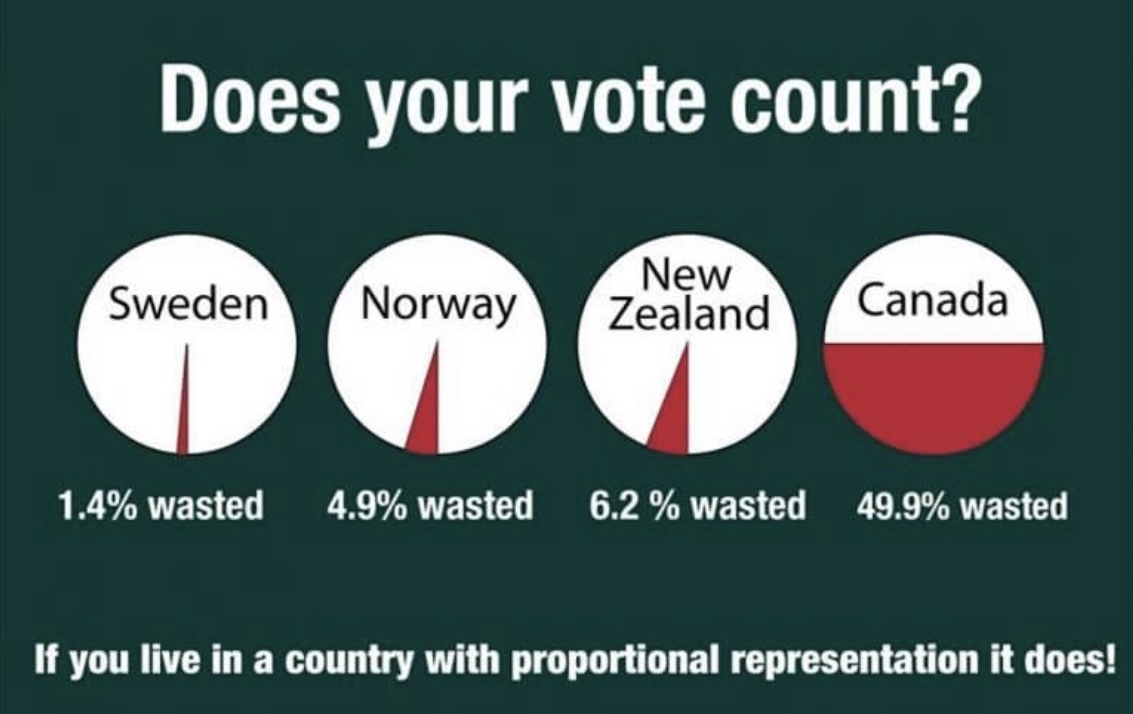Canada 0.01% away from being Poland
Fairvote Canada
What is This Group is About?/De Quoi Parle ce Groupe?
The unofficial Lemmy movement to bring proportional representation to all levels of government in Canada.
Voters deserve more choice and accountability from all politicians.
Le mouvement non officiel de Lemmy visant à amener la représentation proportionnelle à tous les niveaux de gouvernement au Canada.
Les électeurs méritent davantage de choix et de responsabilité de la part de tous les politiciens.
- What is First-Past-The-Post (FPP)?
- What is Proportional Representation (PR)?
- What is a Citizens’ Assembly?
- Why referendums aren't necessary
Related Communities/Communautés Associées
Resources/Ressources
Official Organizations/Organisations Officielles
- Fair Vote Canada
- Fair Voting BC
- Charter Challenge for Fair Voting
- Make Votes Equal / Make Seats Match Votes
- FairVote US
- Make Votes Matter UK
We're looking for more moderators, especially those who are of French and indigenous identities.
Nous recherchons davantage de modérateurs, notamment ceux qui sont d'identité française et autochtone.
And Indonesia
Upside down Indonesia. And upside down Monaco.
And Thüringen
You see, you have the think about it from the perspective of a Liberal or Conservative politican toady: to them it's working exactly as intended.
From my point of view the Jedi are evil.
Only the Sith deal in absolutes.
Wait... that's an absolute.
AB-SO-LUTELY!

If voting is not representative of the will or support of the people as a whole ..... why keep referring to it as a Democracy?
Marketing.
Approved by most dentists!
What’s the math on this?
https://en.m.wikipedia.org/wiki/First-past-the-post_voting
Sorry, I can't give you the math because I'm so bored after reading three plodding articles about voting.
The gist is that fptp voting like the US or Canada has is inferior to ranked choice voting, which means your preferences are always considered even if your first choice doesn't win.
I was really looking forward to that bath though 🥺
J/k thanks
Scrub me daddy
Haha, the voting explanations were so boring I couldn't bother to check for autocorrect errors
I think it's not a first past the post criticism but a single member districts criticism.
An example of what I mean: you have a body made up of 100 representatives. You can divide the body into 100 voting districts. In each one, the winner gets the seat. Even if you have something like RCV, you can have 49% of people vote for party a and 51% vote for party b. If the voting districts are pretty much the same, then party b will have all the seats and 49% of people won't have someone they voted for in power. With proportional representation and multiple member districts, in the case where roughly 50% of people like party a and 50% like party b, the representatives will be roughly 50% party a and 50% party b.
If the voting districts are pretty much the same
And it can get worse if the districts are different. If you pack voters strategically, it's possible for a majority government to form with only slightly over 25% of the popular vote. (Or lower, with more than two parties)
Solid point, well written, way more informative than every article I read, haha, thank you.
Can we all make up numbers?
Idk, can you?
As someone from a first past the post country, can you explain how party members are decided in proportional representation? Are you voting for specific individuals or a party? How does it work if there's a party whose platform you support, but perhaps individuals you do not like?
Is the party's slate of potential representatives pre-decided in order of voter preference in some sort of primary before the election, then they just go down the list in order to fill seats once they know how many seats they get in the general election?
In Denmark there are 10 districts in total of varying sizes but each elect between 2 and 20 representatives for a total of 135, accounting for about 77% of the seats in parliament. 40 additional seats are then distributed in order to fit a party's amount of seats with their national result.
As a vote you either vote for a party or a person.
Each election a party either decides to let their members' personal votes decide their ranking when deciding who receives a seat, or they publish a ranking before the election. In that case a party member's personal votes are practically a vote for the party. You vote for a specific party member can then go to someone else of that party.
There's several systems in use. In short and from memory:
Ranked choice voting is good for electing 1 representative per voting group, so would be good for electing a president for example or a senator in a small us state.
A popular method in parliamentary democracies is the D'Hondt method, which is used for electing multiple representatives per voting group (country, district, whatever). The D'Hondt method still gives a minor advantage to larger parties over smaller ones.
With the D'Hondt method, you can either vote for the list or for a person on the list. The sum of list + direct votes will determine how many representatives will come from that list.
List votes will be distributed starting at the top of the list, according to need to meet the threshold. It's basically as you described. Sometimes a celebrity might be dropped somewhere in the middle of the list (or in the very visible last spot) and get elected without benefitting from list votes.
Being a career politician takes years of work and politicians who got a lot of votes in past elections, will receive better list positions in future elections. So persons at the top of the lists will typically get more direct votes as well.
The method of vote distribution does not determine how the voting lists are created. The different parties can have different rules on how to create their voting lists, but typically it will be the regional party leadership that creates the lists for their regional elections, based on past performance but also on political chicanery. The regional party leadership will have been typically elected by the regional party membership.
If I like a party platform but dislike an individual within that party, then I weigh my decision on the chances of that person getting into a position of power if that party was to form the government. If they stand to become a minister, then I won't vote for anyone from that party.
I personally never vote for lists, always for persons. Even if that person does not get elected, receiving more direct votes will give them more say within their party.
